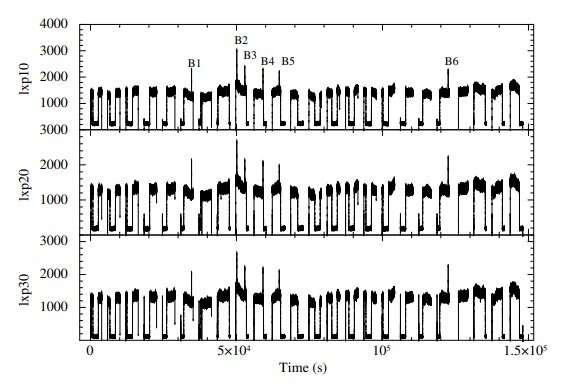#AstroSat observations detect thermonuclear X-ray bursts on Cygnus X-2
“#AstroSat observations detect thermonuclear X-ray bursts on Cygnus X-2”

Using the AstroSat spacecraft, Indian astronomers have identified thermonuclear X-ray bursts on the low-mass X-ray binary (LMXB) Cygnus X-2. The finding, reported in a paper published August 17 on the arXiv preprint server, could shed more light on the nature of this source.
X-ray binaries consist of a normal star or a white dwarf transferring mass onto a compact neutron star or a black hole. Based on the mass of the companion star, astronomers divide them into low-mass X-ray binaries (LMXB) and high-mass X-ray binaries (HMXB).
LMXBs may exhibit transient outbursts, during which an increase in X-ray luminosities is observed. Some of these outbursts are characterized as type I X-ray bursts—thermonuclear explosions taking place on the surface layers of neutron stars.
Discovered in 1965, Cygnus X-2 (Cyg X-2 for short) is a neutron star LMXB with an orbital period of about 9.84 days. The mass of the neutron star is approximately 1.71 solar masses, while the mass of its companion, an evolved late-type star, is estimated to be between 0.4 and 0.7 solar masses.
Since the detection of Cyg X-2, a number of type I X-ray bursts, burst-like events and quasi-periodic oscillations (QPOs) have been observed from this source. Now, a team of astronomers led by Jincy Devasia of the Henry Baker College in Melukavu, India, reports the discovery of five new type I X-ray bursts and one burst-like event in Cyg X-2. The finding was made with the Large Area X-ray Proportional Counter (LAXPC) instrument onboard the AstroSat satellite.
“In this work, we present the results of timing and spectral analysis of AstroSat/LAXPC observations of Cyg X-2 carried out in 2016 and report the detection of five type I thermonuclear X-ray bursts and one burst-like event,” the astronomers wrote in the paper.
The LAXPC instrument detected the presence of a total of six X-ray-burst-like peaks. The bursts, designated B1 to B6, are generally weak, lasting between four and six seconds.
The events have burst peak-to-persistent intensity ratios below 3.0, decay times of about 1-1.5 seconds, and fluences of around 0.01 milliergs/cm2. All of the bursts exhibit a blackbody temperature in the range 1-2 keV while their radii are between 5 and 18 km. B5 was found to exhibit a substructure with two peaks, which distinguishes it from the other five bursts that were classified as type I X-ray bursts.
According to the paper, the properties of B5 are similar to those of the burst-like events previously reported on Cyg X-2, while the characteristics of the remaining five events are consistent with typical thermonuclear X-ray explosions identified by other studies. The results suggest that the newly detected bursts are helium-fuelled flashes.
The astronomers concluded that all in all, Cyg X-2 was entering the early flaring branch (FB) during the AstroSat observations in 2016.
“Using results from our analysis we infer that during this observation in 2016, Cyg X-2 can be characterized as being in the early FB with a puffed up accretion disk and a clumpy coronal structure while undergoing medium-to-high levels of accretion,” the authors of the paper wrote.
More information:
Thermonuclear X-ray bursts detected in Cyg X-2 using AstroSat/LAXPC, arXiv:2008.07172 [astro-ph.HE] arxiv.org/abs/2008.07172
© 2020 Science X Network
AstroSat observations detect thermonuclear X-ray bursts on Cygnus X-2 (2020, August 26)
retrieved 26 August 2020
from https://phys.org/news/2020-08-astrosat-thermonuclear-x-ray-cygnus-x-.html
This document is subject to copyright. Apart from any fair dealing for the purpose of private study or research, no
part may be reproduced without the written permission. The content is provided for information purposes only.
If you want to read more Like this articles, you can visit our Science category.
if you want to watch Movies or Tv Shows go to Dizi.BuradaBiliyorum.Com for forums sites go to Forum.BuradaBiliyorum.Com



